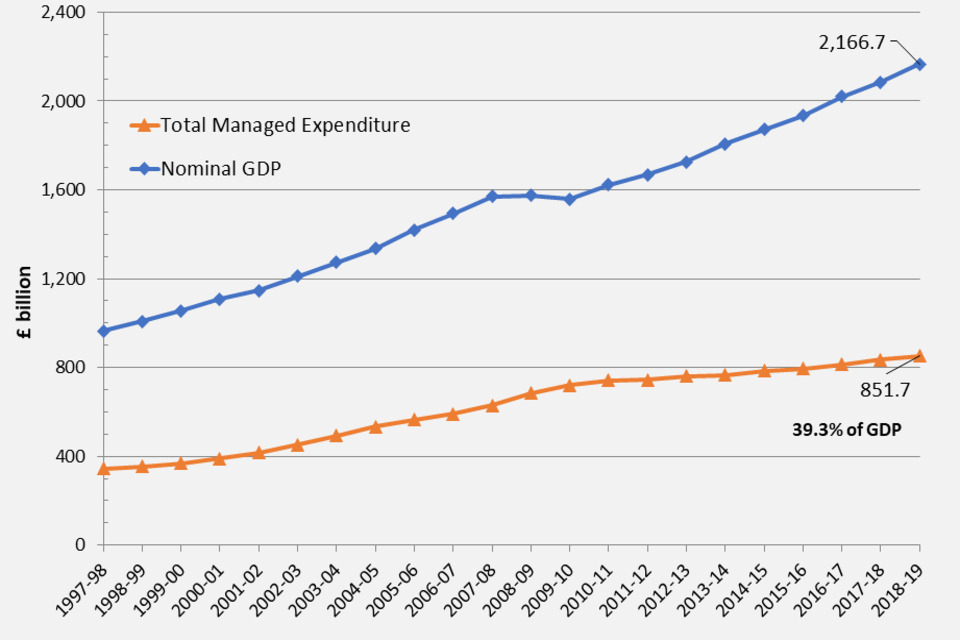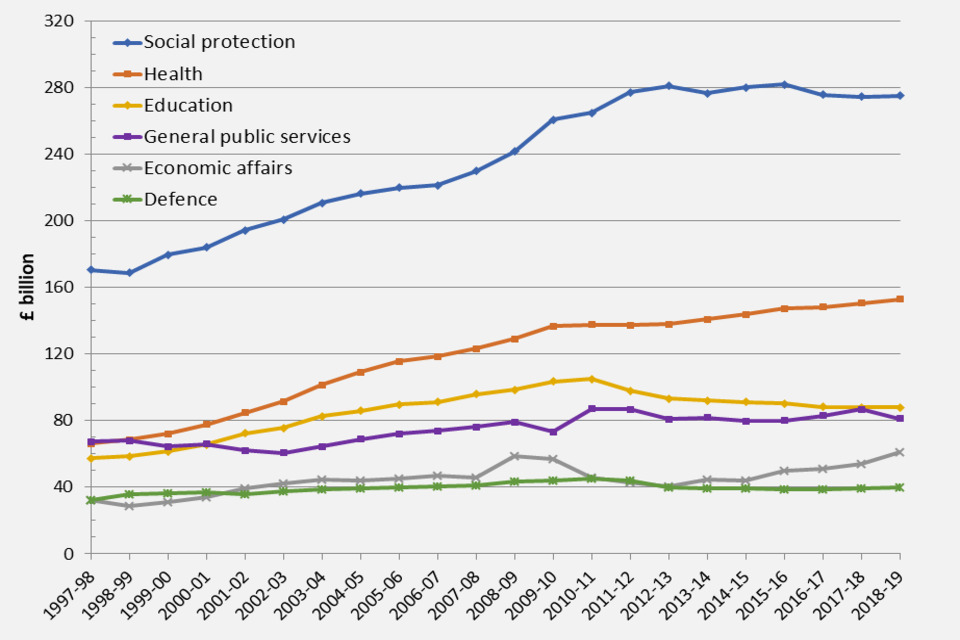Public spending statistics: May 2020
Published 7 May 2020
1. About this release
This release presents updated Public Spending data for the years 2014-15 to 2018-19. All data in this release are National Statistics and are on an outturn basis. TME figures are consistent with data published by the ONS from April 2020. All data and further background detail can be found in the accompanying tables published alongside this release. We welcome any feedback at statistics-enquiries@hmtreasury.gov.uk
2. Total expenditure (£billions)
| Expenditure | 2017-18 | 2018-19 |
|---|---|---|
| Total DEL expenditure | 358.8 | 371.5 |
| Resource departmental AME | 432.9 | 244.6 |
Budgets are divided into Departmental Expenditure Limits (DEL), which are firm plans for three or four years, and Annually Managed Expenditure (AME), covering spending which is demand-led, less predictable and more difficult to control. In the accompanying excel tables, table 1 shows the aggregate position for all departments and all types of spending, with some of the main types of spending shown separately. Table 8 shows in detail how the budgeting data is used to construct the Total Managed Expenditure (TME) figures published by the Office for National Statistics. These are based on National Accounts concepts and are used in the aggregates which underlie the government’s fiscal policy.
| Expenditure | 2017-18 | 2018-19 |
|---|---|---|
| Total Managed Expenditure (TME) | 835.1 | 851.7 |
| Total expenditure on services (TES) | 750.5 | 773.3 |
- TME was £851.7 billion in 2018-19, an increase of 2.0 per cent on the previous year.
- TES was £773.3 billion in 2018-19, an increase of 3.0 per cent on the previous year.
3. Total Departmental Expenditure Limits, 2018-19 (£millions)
For the full table, including years from 2014-15 onward, please refer to Table 7 in the accompany budget tables excel.
| Departmental Group | Total DEL |
|---|---|
| Defence | 38,026 |
| Single Intelligence Account | 2,741 |
| Home Office | 11,667 |
| Foreign and Commonwealth Office | 2,378 |
| International Development | 10,295 |
| Health and Social Care | 130,300 |
| Work and Pensions | 6,094 |
| Education | 66,659 |
| Business, Energy and Industrial Strategy | 11,889 |
| Transport | 10,753 |
| Exiting the European Union | - |
| Digital, Culture, Media and Sport | 1,890 |
| MHCLG - Housing and Communities | 9,757 |
| MHCLG - Local Government | 4,834 |
| Scotland | 18,854 |
| Wales | 15,344 |
| Northern Ireland | 11,778 |
| Justice | 7,941 |
| Law Officers’ Departments | 563 |
| Environment, Food and Rural Affairs | 2,488 |
| HM Revenue and Customs | 4,012 |
| HM Treasury | 408 |
| Cabinet Office | 713 |
| International Trade | 424 |
| Small and Independent Bodies | 1,658 |
Please note: A Machinery of Government change has transferred all of the functions of the Department for Exiting the European Union to the Cabinet Office. This table reflects that change.
3.1 Budgeting Statistics (Tables 1 to 9)
- Total DEL expenditure (Resource DEL excluding depreciation plus Capital DEL) was £371.5 billion in 2018-19, an increase of £12.6 billion or 3.5 per cent on the previous year in nominal terms.
- Total departmental expenditure (Total DEL plus resource and capital departmental AME) was £628.6 billion in 2018-19, a decrease of £184.3 billion or 22.7 per cent on the previous year. This is mainly due to a larger than normal figure for Resource departmental AME in 2017-18, which reflected a significant change in the accounting valuation of provisions following a change in the long-term Treasury discount rate.
- Resource departmental AME was £244.6 billion in 2018-19, a decrease from £432.9 billion in 2017-18. The increased resource departmental AME expenditure in 2017-18 reflected a significant change in the accounting valuation of provisions as a result of changes in the long-term Treasury discount rate which inflated the present value of expected future long-term costs. The largest decrease in 2018-19 was for Business, Energy and Industrial Strategy (£181 billion) which mainly reflected lower provisions for the Nuclear Decommissioning Authority (NDA). This was a non-cash charge.
In the accompanying excel tables, tables 1 to 9 show central government departmental spending on a budgetary basis. These are the aggregates used by the government to plan and control expenditure. They cover departments’ own spending as well as support to local government and public corporations. They are consistent with “Estimates” voted by Parliament and broadly consistent with departmental Resource Accounts, which are based on commercial International Financial Reporting Standards (IFRS) adapted for the public sector.
4. Real terms public expenditure (£billions)
| Functions | 2017-18 | 2018-19 |
|---|---|---|
| General public services | 86.9 | 81.3 |
| Defence | 39.5 | 40.2 |
| Public order and safety | 32.1 | 32.4 |
| Economic affairs | 54.3 | 61.0 |
| Environment protection | 12.0 | 11.1 |
| Housing and community amenities | 11.6 | 12.1 |
| Health | 150.5 | 152.9 |
| Recreation, culture and religion | 11.7 | 11.4 |
| Education | 87.9 | 87.9 |
| Social protection | 274.5 | 275.1 |
In the accompanying excel tables, tables 10 to 11 present spending under the “expenditure on services” framework. This is based on National Accounts definitions and covers the whole of the public sector. It therefore has wider coverage than the budgeting framework and is also more stable over time.
4.1 Trends in functional expenditure (Tables 10, 10a and 10b)
Compared with the previous year:
- in real terms, spending on six of the ten functions (not including EU transactions) increased during 2018-19, whilst three showed a decrease
- the largest real terms growth in expenditure in percentage terms was on Economic affairs which increased by 12.4 per cent. This was followed by Housing and community amenities which grew by 4.5 per cent and Defence and Health which grew by 1.9 per cent and 1.6 per cent on 2017-18, respectively
- the largest real terms fall in spending was in Environment protection which went down by 7.8 per cent. General public services and Recreation, culture and religion fell by 6.5 per cent and 3.1 per cent, respectively
In the accompanying excel tables, tables 10, 10a and 10b show public sector expenditure on services broken down by function over a longer number of years, allowing long-term trends to be identified. Table 11 presents data broken down by economic categories such as pay or grants.
5. National Statistics
The United Kingdom Statistics Authority has designated these statistics as National Statistics, in accordance with the Statistics and Registration Service Act 2007 and signifying compliance with the Code of Practice for Official Statistics. Designation can be broadly interpreted to mean that the statistics:
- meet identified user needs
- are well explained and readily accessible
- are produced according to sound methods
- are managed impartially and objectively in the public interest
Once statistics have been designated as National Statistics it is a statutory requirement that the Code of Practice shall continue to be observed.
6. Spending frameworks used in HM Treasury spending publications
| Budgeting | Expenditure on services (TES) |
|---|---|
| This framework provides information on central government departmental budgets, which are the aggregates used by the government to plan and control expenditure. It covers departmental own spending as well as support to local government and public corporations. | This framework is used in HM Treasury publications for statistical analysis. It is based on National Accounts definitions and covers spending by the whole of the public sector. It therefore has wider coverage than the budgeting framework and is also more stable over time. |
7. Trends in public spending
7.1 Chart 1: Trends in public spending since 1997-98

- During the recession, as GDP shrank but spending increased, TME took an increasingly large share of national income. As a result, TME as a percentage of GDP peaked at 46.3 per cent in 2009-10. In the subsequent years, TME as a percentage of GDP has been decreasing. In 2018-19 it stood at 39.3 per cent of GDP (Table 10b).
- In 2018-19 public expenditure on Health was equal to 7.1 per cent of GDP, compared to 4.6 per cent in 1997-98. Education spending stood at 4.0 per cent in 1997-98 compared to 4.1 per cent of GDP in 2018-19. These changes reflect a mix of demographics and the policy priorities of successive governments.
- The share of GDP taken by public sector debt interest payments was 2.6 per cent in 2018-19. This compares with a peak of 3.7 per cent last seen in 1997-98, when interest rates were significantly higher than now.
7.2 Chart 2: Real terms trends in Public Spending

From 2011-12 onwards the ‘grant-equivalent element of student loans’ is no longer part of the TES framework and has therefore been removed from the Education function. Therefore figures are not directly comparable between 2010-11 and 2011-12. A full explanation of this decision can be found in PESA 2019 Annex E.
In real terms (i.e. after adjusting for the effect of inflation):
- spending on Social Protection was £275.1 billion in 2018-19, up from £274.5 billion in the previous year
- health spending (including spending by central government departments and devolved administrations) was £152.9 billion in 2018-19, compared to £150.5 billion spent in 2017-18
8. Revisions in this release (since Feb 2020 publication)
| Expenditure | Amount (£millions) | Comments |
|---|---|---|
| Total DEL expenditure | +£141m | Resource and Capital DEL (excluding depreciation) has been revised up in 2018-19. Driven mainly by changes to Capital DEL reported by the Department for Business, Energy and Industrial Strategy (BEIS). |
| Resource departmental AME | -£39m | Driven mainly by BEIS. The changes reflect data being brought into line with their 2018-19 resource accounts. |
Changes to Total Managed Expenditure (TME) and public sector debt interest in all years are due to updated ONS data. More information about these changes is available in the monthly ONS public sector finances (PSF) release
9. Additional information about the PSS release
9.1 Upcoming revisions and changes in forthcoming releases
The PSS release is now published in an HTML format (this publication was previously available as a pdf). These changes have been made with the aim of improving the accessibility and presentation of the publication. The next HM Treasury PSS National Statistics release will be published in July 2020, alongside the Public Expenditure Statistical Analyses (PESA) release. There are no expected changes to the spending frameworks for the next release.
9.2 PSS publication schedule for the coming year
| Date | Release |
|---|---|
| July 2020 | The July PSS release contains the first publication of departmental spending outturn for the 2019-20 financial year. Local authority data and much of the data from the devolved administrations are still provisional at this stage of the year. This is the main annual release. |
| Nov 2020 | As well as the PSS release, the Country and Regional Analysis (CRA) is also published in November each year. |
| Feb 2021 | This release contains updates to the key Public Spending Statistics series. It includes updated data for local authorities for the previous financial year. |
